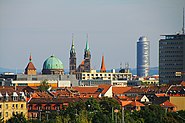Our website is made possible by displaying online advertisements to our visitors.
Please consider supporting us by disabling your ad blocker.
Nuremberg
Nuremberg
| |
|---|---|
| Coordinates: 49°27′14″N 11°04′39″E / 49.45389°N 11.07750°E | |
| Country | Germany |
| State | Bavaria |
| Admin. region | Middle Franconia |
| District | Urban district |
| Subdivisions | 10 districts |
| Government | |
| • Lord mayor (2020–26) | Marcus König[1] (CSU) |
| Area | |
• City | 186.46 km2 (71.99 sq mi) |
| Elevation | 302 m (991 ft) |
| Population (2023-12-31)[2] | |
• City | 526,091 |
| • Density | 2,800/km2 (7,300/sq mi) |
| • Urban | 1,374,524 |
| • Metro | 3,610,543 |
| Time zone | UTC+01:00 (CET) |
| • Summer (DST) | UTC+02:00 (CEST) |
| Postal codes | 90000-90491 |
| Dialling codes | 0911, 09122, 09129 |
| Vehicle registration | N |
| Website | nuernberg.de |
Nuremberg (/ˈnjʊərəmbɜːrɡ/, NURE-əm-burg; German: Nürnberg [ˈnʏʁnbɛʁk] ⓘ; in the local East Franconian dialect: Nämberch [ˈnɛmbɛrç]) is the largest city in Franconia, the second-largest city in the German state of Bavaria, and its 544,414 (2023) inhabitants[3] make it the 14th-largest city in Germany.
Nuremberg sits on the Pegnitz, which carries the name Regnitz from its confluence with the Rednitz in Fürth onwards (Pegnitz→ Regnitz→ Main→ Rhine→ North Sea), and on the Rhine–Main–Danube Canal, that connects the North Sea to the Black Sea. Lying in the Bavarian administrative region of Middle Franconia, it is the largest city and unofficial capital of the entire cultural region of Franconia. The city is surrounded on three sides by the Nürnberger Reichswald, a large forest, and in the north lies Knoblauchsland (garlic land), an extensive vegetable growing area and cultural landscape.
The city forms a continuous conurbation with the neighbouring cities of Fürth, Erlangen and Schwabach, which is the heart of an urban area region with around 1.4 million inhabitants,[4] while the larger Nuremberg Metropolitan Region has a population of approximately 3.6 million. It is the largest city in the East Franconian dialect area (colloquially: "Franconian"; German: Fränkisch).
Nuremberg and Fürth were once connected by the Bavarian Ludwig Railway, the first steam-hauled and overall second railway opened in Germany (1835). Today, the U1 of the Nuremberg U-Bahn runs along this route. Subway lines U2 and U3 are the first German driverless subway lines, automatically moving railcars.[5] Nuremberg Airport (Flughafen Nürnberg "Albrecht Dürer") is the second-busiest airport in Bavaria after Munich Airport, and the tenth-busiest airport in the country.
Institutions of higher education in Nuremberg include the University of Erlangen-Nuremberg (Friedrich-Alexander-Universität Erlangen-Nürnberg), Germany's 11th-largest university, with campuses in Erlangen and Nuremberg and a university hospital in Erlangen (Universitätsklinikum Erlangen), Technische Hochschule Nürnberg Georg Simon Ohm, Hochschule für Musik Nürnberg and the newly founded University of Technology Nuremberg. The Nuremberg exhibition centre (Messe Nürnberg) is one of the biggest convention center companies in Germany and operates worldwide.
Nuremberg Castle, its medieval old town and the city's walls, with their many towers, are notable attractions. Staatstheater Nürnberg is one of the five Bavarian state theatres,[a] showing operas, operettas, musicals, and ballets (main venue: Nuremberg Opera House), plays (main venue: Schauspielhaus Nürnberg), as well as concerts (main venue: Meistersingerhalle). Its orchestra, the Staatsphilharmonie Nürnberg, is Bavaria's second-largest opera orchestra after the Bavarian State Opera's Bavarian State Orchestra in Munich. Nuremberg is the birthplace of Albrecht Dürer and Johann Pachelbel. 1. FC Nürnberg is the most famous football club of the city and one of the most successful football clubs in Germany. Nuremberg was one of the host cities of the 2006 FIFA World Cup.
- ^ "Liste der Oberbürgermeister in den kreisfreien Städten". Bayerisches Landesamt für Statistik. Archived from the original on 30 June 2021. Retrieved 19 July 2021.
- ^ Genesis Online-Datenbank des Bayerischen Landesamtes für Statistik Tabelle 12411-003r Fortschreibung des Bevölkerungsstandes: Gemeinden, Stichtag (Einwohnerzahlen auf Grundlage des Zensus 2011).
- ^ "Daten und Fakten - Stadtportal Nürnberg". www.nuernberg.de. Archived from the original on 23 July 2017. Retrieved 25 July 2024.
- ^ Region Nürnberg Archived 4 July 2022 at the Wayback Machine on hey.bayern
- ^ "VAG: 15 years of the automatic Nuremberg subway – a successful project" (in German). 14 June 2023. Archived from the original on 24 March 2024. Retrieved 25 March 2024.
Cite error: There are <ref group=lower-alpha> tags or {{efn}} templates on this page, but the references will not show without a {{reflist|group=lower-alpha}} template or {{notelist}} template (see the help page).
Previous Page Next Page













